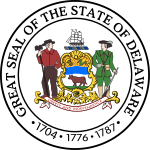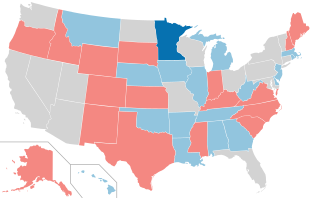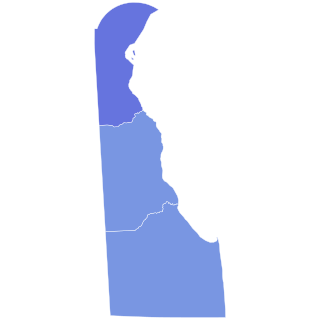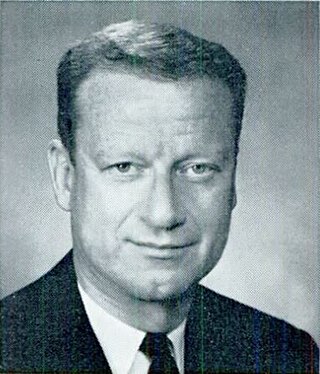| |||||||||||||||||
| |||||||||||||||||
Map key Roth: 50–60% 60–70% 70–80% | |||||||||||||||||
| |||||||||||||||||
| Elections in Delaware |
|---|
 |
The 1976 United States Senate election in Delaware took place on November 2, 1976. Incumbent Republican U.S. Senator Bill Roth won reelection to a second term.
| |||||||||||||||||
| |||||||||||||||||
Map key Roth: 50–60% 60–70% 70–80% | |||||||||||||||||
| |||||||||||||||||
| Elections in Delaware |
|---|
 |
The 1976 United States Senate election in Delaware took place on November 2, 1976. Incumbent Republican U.S. Senator Bill Roth won reelection to a second term.
| Party | Candidate | Votes | % | |
|---|---|---|---|---|
| Republican | William Roth (incumbent) | 125,454 | 55.81% | |
| Democratic | Thomas Maloney | 98,042 | 43.61% | |
| American | Donald G. Gies | 646 | 0.29% | |
| Non-Partisan | Joseph F. McInerney | 437 | 0.19% | |
| Prohibition | John A. Massimilla | 216 | 0.0% | |
| Majority | 27,412 | 12.20% | ||
| Turnout | 224,795 | |||
| Republican hold | ||||
| County [6] | William Victor Roth Jr. Republican | Thomas Maloney Democratic | Donald G. Giles American | Joseph F. McInerney Non-Partisan | John A. Massimilla Prohibition | Total |
|---|---|---|---|---|---|---|
| Kent | 13,481 | 14,359 | 86 | 44 | 42 | 28,012 |
| New Castle | 93,267 | 68,610 | 486 | 323 | 142 | 162,828 |
| Sussex | 18,754 | 15,086 | 74 | 73 | 32 | 34,019 |
| Total | 125,502 | 98,055 | 646 | 440 | 216 | 224,859 |

The 1990 United States Senate elections were held on Tuesday, November 6, 1990, with the 33 seats of Class 2 contested in regular elections. Special elections were also held to fill vacancies. The Democratic Party increased its majority with a net gain of one seat from the Republican Party. The election took place in the middle of President George H. W. Bush's term, and, as with most other midterm elections, the party not holding the presidency gained seats in Congress.

The 1988 United States Senate elections were elections for the United States Senate. Held on November 8, the 33 seats of Class 1 were contested in regular elections. In spite of the Republican victory by George H. W. Bush in the presidential election, the Democrats gained a net of one seat in the Senate. Seven seats changed parties, with four incumbents being defeated. The Democratic majority in the Senate increased by one to 55–to–45.

The 1986 United States Senate elections were elections for the United States Senate. Held on November 4, in the middle of Ronald Reagan's second presidential term, the 34 seats of Class 3 were contested in regular elections. The Republicans had to defend an unusually large number of freshman Senate incumbents who had been elected on President Ronald Reagan's coattails in 1980. Democrats won a net of eight seats, defeating seven freshman incumbents, picking up two Republican-held open seats, and regaining control of the Senate for the first time since January 1981. This remains the most recent midterm election cycle in which the sitting president's party suffered net losses while still flipping a Senate seat.

The 1984 United States Senate elections were held on November 6, with the 33 seats of Class 2 contested in regular elections. They coincided with the landslide re-election of President Ronald Reagan in the presidential election. In spite of the lopsided presidential race, Reagan's Republican Party suffered a net loss of two Senate seats to the Democrats, although it retained control of the Senate with a reduced 53-47 majority. Democrats defeated incumbents in Illinois and Iowa, and won an open seat in Tennessee, while Republicans defeated an incumbent in Kentucky.

The 1978 United States Senate elections were held on November 7, in the middle of Democratic President Jimmy Carter's term. The 33 seats of Class 2 were contested in regular elections. Special elections were also held to fill vacancies.

The 1976 United States Senate elections was an election for the United States Senate. Held on November 2, the 33 seats of Class 1 were contested in regular elections. They coincided with Democrat Jimmy Carter's presidential election and the United States Bicentennial celebration. Although almost half of the seats decided in this election changed parties, Carter's narrow victory did not provide coattails for the Democratic Party. Each party flipped seven Senate seats, although, one of the seats flipped by Democrats was previously held by a Conservative.

The 1972 United States Senate elections were held on November 7, with the 33 seats of Class 2 contested in regular elections. They coincided with the landslide re-election of Republican President Richard Nixon. Despite Nixon's landslide victory, Democrats increased their majority by two seats. The Democrats picked up open seats in Kentucky and South Dakota, and defeated four incumbent senators: Gordon Allott of Colorado, J. Caleb Boggs of Delaware, Jack Miller of Iowa, and Margaret Chase Smith of Maine. The Republicans picked up open seats in New Mexico, North Carolina, and Oklahoma, and defeated one incumbent, William B. Spong Jr. of Virginia.

The 1970 United States Senate elections was an election for the United States Senate. It took place on November 3, with the 33 seats of Class 1 contested in regular elections. Special elections were also held to fill vacancies. These races occurred in the middle of Richard Nixon's first term as president. The Democrats lost a net of three seats, while the Republicans and the Conservative Party of New York picked up one net seat each, and former Democrat Harry F. Byrd Jr. was re-elected as an independent.

The 1958 United States Senate elections were elections for the United States Senate which occurred in the middle of President Dwight D. Eisenhower's second term. Thirty-two seats of Class 1 were contested in regular elections, the new state of Alaska held its first Senate elections for its Class 2 and 3 seats, and two special elections were held to fill vacancies.

The 1954 United States Senate elections was a midterm election in the first term of Dwight D. Eisenhower's presidency. The 32 Senate seats of Class 2 were contested in regular elections, and six special elections were held to fill vacancies. Eisenhower's Republican party lost a net of two seats to the Democratic opposition. This small change was just enough to give Democrats control of the chamber with the support of an Independent who agreed to caucus with them, he later officially joined the party in April 1955.

The 1952 United States Senate elections was an election for the United States Senate which coincided with the election of Dwight D. Eisenhower to the presidency by a large margin. The 32 Senate seats of Class 1 were contested in regular elections, and three special elections were held to fill vacancies. The Republicans took control of the Senate by managing to make a net gain of two seats. However, Wayne Morse (R-OR) became an independent forcing Republicans to rely on Vice President Richard Nixon's tie-breaking vote, although Republicans maintained a 48-47-1 plurality. Throughout the next Congress, Republicans were able to restore their 49-46-1 majority. This was the third time, as well as second consecutive, in which a sitting Senate leader lost his seat.

The 1946 United States Senate elections were held November 5, 1946, in the middle of Democratic President Harry S. Truman's first term after Roosevelt's passing. The 32 seats of Class 1 were contested in regular elections, and four special elections were held to fill vacancies. The Republicans took control of the Senate by picking up twelve seats, mostly from the Democrats. This was the first time since 1932 that the Republicans had held the Senate, recovering from a low of 16 seats following the 1936 Senate elections.

The 1932 United States Senate elections coincided with Democrat Franklin D. Roosevelt's landslide victory over incumbent Herbert Hoover in the presidential election. The 32 seats of Class 3 were contested in regular elections, and special elections were held to fill vacancies.

The 1930 United States Senate elections occurred in the middle of Republican President Herbert Hoover's term. The 32 seats of Class 2 were contested in regular elections, and special elections were held to fill vacancies. With the Great Depression beginning to take hold, Republican incumbents became unpopular, and Democrats picked up a net of eight seats, erasing the Republican gains from the previous election cycle. Republicans retained control of the U.S. Senate since Vice President Charles Curtis cast the tie-breaking vote. This was the first of four consecutive Senate elections during the Depression in which Democrats made enormous gains, achieving a cumulative pick-up of 34 seats.

The 1976 United States Senate election in Florida was held on November 2, 1976. Incumbent Democratic U.S. Senator Lawton Chiles won re-election to a second term.

The 1984 United States Senate election in Delaware was held on November 6, 1984. Incumbent Democratic Senator Joe Biden won re-election to a third term, defeating Republican challenger John M. Burris.

The 1978 United States Senate election in Delaware was held on November 7, 1978. Incumbent Democratic United States Senator Joe Biden won re-election to a second term, defeating Republican challenger James H. Baxter Jr. in a landslide victory. This is the first of five elections that Biden won all counties.

The 1978 United States Senate election in Alaska was held on November 7, 1978. Incumbent Republican U.S. Senator Ted Stevens was re-elected to a third term in office, defeating Democrat Donald Hobbs.

The 1942 United States Senate election in Iowa took place on November 3, 1942. Incumbent Democratic Senator Clyde Herring ran for re-election to a second term but was defeated by Republican Governor George A. Wilson.

The 1970 United States Senate election in Delaware took place on November 2, 1970. Incumbent Republican U.S. Senator John J. Williams retired. Republican Party U.S. Representative Bill Roth was elected to succeed him.